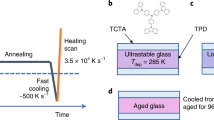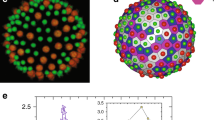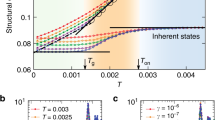Abstract
The cooperative rearrangement of groups of many molecules has long been thought to underlie the dramatic slowing of liquid dynamics on cooling towards the glassy state. For instance, there exists experimental evidence for cooperatively rearranging regions (CRRs) on the nanometre length scale near the glass transition. The random first-order transition (RFOT) theory of glasses predicts that, near the glass-transition temperature, these regions are compact, but computer simulations and experiments on colloids suggest CRRs are string-like. Here, we present a microscopic theory within the framework of RFOT, which unites the two situations. We show that the shapes of CRRs in glassy liquids should change from being compact at low temperatures to fractal or ‘stringy’ as the dynamical crossover temperature from activated to collisional transport is approached from below. This theory predicts a correlation of the ratio of the dynamical crossover temperature to the laboratory glass-transition temperature, and the heat-capacity discontinuity at the glass transition. The predicted correlation quantitatively agrees with experimental results for 21 materials.
This is a preview of subscription content, access via your institution
Access options
Subscribe to this journal
Receive 12 print issues and online access
$209.00 per year
only $17.42 per issue
Buy this article
- Purchase on Springer Link
- Instant access to full article PDF
Prices may be subject to local taxes which are calculated during checkout






Similar content being viewed by others
References
Singh, Y., Stoessel, J. P. & Wolynes, P. G. Hard-sphere glass and the density-functional theory of aperiodic crystals. Phys. Rev. Lett. 54, 1059–1062 (1985).
Kirkpatrick, T. R. & Wolynes, P. G. Connections between some kinetic and equilibrium theories of the glass transition. Phys. Rev. A 35, 3072–3080 (1987).
Kirkpatrick, T. R. & Wolynes, P. G. Stable and metastable states in mean-field potts and structural glasses. Phys. Rev. B 36, 8552–8564 (1987).
Kirkpatrick, T. R. & Thirumalai, D. Dynamics of the structural glass-transition and the p-spin-interaction spin-glass model. Phys. Rev. Lett. 58, 2091–2094 (1987).
Mezard, M. & Parisi, G. Thermodynamics of glasses: A first principles computation. Phys. Rev. Lett. 82, 747–750 (1999).
Franz, S. & Toninelli, F. L. A field-theoretical approach to the spin glass transition: models with long but finite interaction range. J. Stat. Mech. Theor. Exp. P01008 (2005).
Franz, S. Metastable states, relaxation times and free-energy barriers in finite dimensional glassy systems. Europhys. Lett. 73, 492–498 (2005).
Bouchaud, J. P. & Biroli, G. On the Adam-Gibbs-Kirkpatrick-Thirumalai-Wolynes scenario for the viscosity increase in glasses. J. Chem. Phys. 121, 7347–7354 (2004).
Kirkpatrick, T. R., Thirumalai, D. & Wolynes, P. G. Scaling concepts for the dynamics of viscous liquids near an ideal glassy state. Phys. Rev. A 40, 1045–1054 (1989).
Xia, X. Y. & Wolynes, P. G. Fragilities of liquids predicted from the random first order transition theory of glasses. Proc. Natl Acad. Sci. 97, 2990–2994 (2000).
Xia, X. Y. & Wolynes, P. G. Microscopic theory of heterogeneity and nonexponential relaxations in supercooled liquids. Phys. Rev. Lett. 86, 5526–5529 (2001).
Ediger, M. D. Spatially heterogeneous dynamics in supercooled liquids. Ann. Rev. Phys. Chem. 51, 99–128 (2000).
Russell, E. V. & Israeloff, N. E. Direct observation of molecular cooperativity near the glass transition. Nature 408, 695–698 (2000).
Deschenes, L. A. & Bout, D. A. V. Single-molecule studies of heterogeneous dynamics in polymer melts near the glass transition. Science 292, 255–258 (2001).
Sillescu, H. Heterogeneity at the glass transition: a review. J. Non-Cryst. Solids 243, 81–108 (1999).
Richert, R. Heterogeneous dynamics in liquids: fluctuations in space and time. J. Phys. Condens. Matter 24, R703–R738 (2002).
Kob, W., Donati, C., Plimpton, S. J., Poole, P. H. & Glotzer, S. C. Dynamical heterogeneities in a supercooled Lennard-Jones liquid. Phys. Rev. Lett. 79, 2827–2830 (1997).
Gebremichael, Y., Vogel, M. & Glotzer, S. C. Particle dynamics and the development of string-like motion in a simulated monoatomic supercooled liquid. J. Chem. Phys. 120, 4415–4427 (2004).
Donati, C. et al. Stringlike cooperative motion in a supercooled liquid. Phys. Rev. Lett. 80, 2338–2341 (1998).
Donati, C., Glotzer, S. C., Poole, P. H., Kob, W. & Plimpton, S. J. Spatial correlations of mobility and immobility in a glass-forming Lennard-Jones liquid. Phys. Rev. E 60, 3107–3119 (1999).
Weeks, E. R., Crocker, J. C., Levitt, A. C., Schofield, A. & Weitz, D. A. Three-dimensional direct imaging of structural relaxation near the colloidal glass transition. Science 287, 627–631 (2000).
Reinsberg, S. A., Heuer, A., Doliwa, B., Zimmermann, H. & Spiess, H. W. Comparative study of the nmr length scale of dynamic heterogeneities of three different glass formers. J. Non-Cryst. Solids 307–310, 208–214 (2002).
Biroli, G. & Bouchaud, J. P. Diverging length scale and upper critical dimension in the mode-coupling theory of the glass transition. Europhys. Lett. 67, 21–27 (2004).
Unger, C. & Klein, W. Nucleation theory near the classical spinodal. Phys. Rev. B 29, 2698–2708 (1984).
Johnson, G., Mel’cuk, A. I., Gould, H., Klein, W. & Mountain, R. D. Molecular-dynamics study of long-lived structures in a fragile glass-forming liquid. Phys. Rev. E 57, 5707–5718 (1998).
Stoessel, J. P. & Wolynes, P. G. Linear excitations and the stability of the hard-sphere glass. J. Chem. Phys. 80, 4502–4512 (1984).
Dasgupta, C. & Valls, O. T. Free energy landscape of a dense hard-sphere system. Phys. Rev. E 59, 3123–3134 (1999).
Fuchizaki, K. & Kawasaki, K. Dynamical density functional theory for glassy behaviour. J. Phys. Condens. Matter 14, 12203–12222 (2002).
Stillinger, F. H. & Weber, T. A. Dynamics of structural transitions in liquids. Phys. Rev. A 28, 2408–2416 (1983).
Hall, R. W. & Wolynes, P. G. Microscopic theory of network glasses. Phys. Rev. Lett. 90, 085505 (2003).
Villain, J. Equilibrium critical properties of random field systems — new conjectures. J. Physique 46, 1843–1852 (1985).
Dzero, M., Schmalian, J. & Wolynes, P. G. Activated events in glasses: The structure of entropic droplets. Phys. Rev. B 72, 100201 (2005).
Stevenson, J. D. & Wolynes, P. G. Thermodynamic-kinetic correlations in supercooled liquids: A critical survey of experimental data and predictions of the random first-order transition theory of glasses. J. Phys. Chem. B 109, 15093–15097 (2005).
Lubchenko, V. & Wolynes, P. G. Barrier softening near the onset of nonactivated transport in supercooled liquids: Implications for establishing detailed connection between thermodynamic and kinetic anomalies in supercooled liquids. J. Chem. Phys. 119, 9088–9105 (2003).
Stauffer, D. Monte-carlo study of density profile, radius, and perimeter for percolation clusters and lattice animals. Phys. Rev. Lett. 41, 1333–1336 (1978).
Leath, P. L. Cluster size and boundary distribution near percolation threshold. Phys. Rev. B 14, 5046–5055 (1976).
Yang, C. N. & Lee, T. D. Statistical theory of equations of state and phase transitions. I Theory of condensation. Phys. Rev. 87, 404–409 (1952).
Sykes, M. F., Gaunt, D. S. & Glen, M. Percolation processes in three dimensions. J. Phys. A 9, 1705–1712 (1976).
Cao, Q. Z. & Wong, P. O. External surface of site percolation clusters in three dimensions. J. Phys. A 25, L69–L74 (1992).
Stickel, F., Fischer, E. W. & Richert, R. Dynamics of glass-forming liquids. 2. detailed comparison of dielectric relaxation, dc-conductivity, and viscosity data. J. Chem. Phys. 104, 2043–2055 (1996).
Novikov, V. N. & Sokolov, A. P. Universality of the dynamic crossover in glass-forming liquids: A ‘magic’ relaxation time. Phys. Rev. E 67, 031507 (2003).
Chui, S. T. & Weeks, J. D. Phase-transition in 2-dimensional Coulomb gas, and interfacial roughening transition. Phys. Rev. B 14, 4976–4982 (1976).
Flory, P. J. Principles of Polymer Chemistry (Cornell Univ. Press, Ithaca, 1953).
Hinze, G., Brace, D. D., Gottke, S. D. & Fayer, M. D. A detailed test of mode-coupling theory on all time scales: Time domain studies of structural relaxation in a supercooled liquid. J. Chem. Phys. 113, 3723–3733 (2000).
Adam, G. & Gibbs, J. H. On the temperature dependence of cooperative relaxation properties in glass-forming liquids. J. Chem. Phys. 43, 139–146 (1943).
Berthier, L. et al. Direct experimental evidence of a growing length scale accompanying the glass transition. Science 310, 1797–1800 (2005).
Tracht, U. et al. Length scale of dynamic heterogeneities at the glass transition determined by multidimensional nuclear magnetic resonance. Phys. Rev. Lett. 81, 2727–2730 (1998).
Böhmer, R. & Angell, C. A. Correlations of the nonexponentiality and state dependence of mechanical relaxations with bond connectivity in Ge-As-Se supercooled liquids. Phys. Rev. B 45, 10091–10094 (1992).
Laughlin, W. T. & Uhlmann, D. R. Viscous flow in simple organic liquids. J. Phys. Chem. 76, 2317–2325 (1972).
Cukierman, M., Lane, J. W. & Uhlmann, D. R. High-temperature flow behavior of glass-forming liquids: A free-volume interpretation. J. Chem. Phys. 59, 3639–3644 (1973).
Acknowledgements
Work at UCSD was supported by NSF grant CHE0317017. J.S. was supported by the Ames Laboratory, operated for the US Department of Energy by Iowa State University under Contract No. W-7405-Eng-82 (J.S.). We would also like to acknowledge K. Schmidt-Rohr for helpful comments.
Author information
Authors and Affiliations
Corresponding authors
Ethics declarations
Competing interests
The authors declare no competing financial interests.
Supplementary information
Rights and permissions
About this article
Cite this article
Stevenson, J., Schmalian, J. & Wolynes, P. The shapes of cooperatively rearranging regions in glass-forming liquids. Nature Phys 2, 268–274 (2006). https://doi.org/10.1038/nphys261
Received:
Accepted:
Published:
Issue Date:
DOI: https://doi.org/10.1038/nphys261
This article is cited by
-
Visualizing slow internal relaxations in a two-dimensional glassy system
Nature Physics (2023)
-
Surface melting of a colloidal glass
Nature Communications (2022)
-
Experimental evidence of mosaic structure in strongly supercooled molecular liquids
Nature Communications (2021)
-
Rules of hierarchical melt and coordinate bond to design crystallization in doped phase change materials
Nature Communications (2021)
-
Glass transition and fragility of nanosized polymeric fibers and spheres predicted from a surface-controlled model
Polymer Journal (2021)



